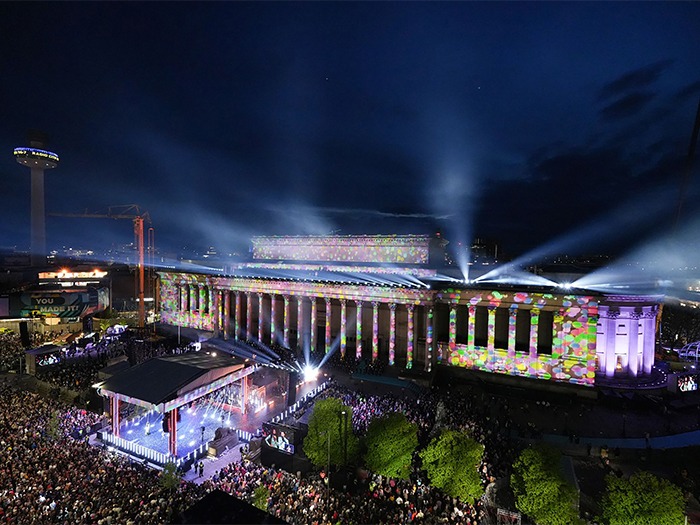Working for TBI Media via Production Box, IPS were onsite in Liverpool providing a series of structures for a National Lottery hosted event that kicked off the 67th Eurovision Song Contest.
The event took place in front of St George’s Hall with a live audience of 25,000 people. The Big Eurovision Welcome was recorded for TV, and broadcast as part of the main contest show content. High profile performers included Frankie Goes to Hollywood who re-united for their first public appearance in 36 years, as well as Lightning Seeds, Atomic Kitten, the Real Thing, Jamie Webster, Eurovision legend Conchita Wurst and many others. This meant that the design considerations had to incorporate a show that not only looked great on camera, but everything also had to work for a large audience too.
The event location presented a series of logistical challenges for production, where everything had to fit into a tight space already filled with Grade 1 listed steps, war memorials and lamp posts – not to mention the bus route between stage and front of house! IPS Owner and Project Manager James Mason took all this in his stride with a long-established working relationship with Mike Oates at Production Box ensuring that structural considerations could be highlighted to the various design teams.
Mike commented that the IPS team were “fantastic to work with”, and “the show wouldn’t have been possible to deliver without them”. The Liverpool City Council team were also very supportive of the project, ensuring that the many complex elements of the show could be approved and get things over the line in the tight timeframes.
IPS Head of Technical Ian Brown took the lead from a structure and build perspective on the project. He worked closely with external structural engineers, fabricators other suppliers to customise the existing IPS Eurotruss PR15 Outdoor Roof Structure to enable it to be used in a sideways configuration with a specially modified truss grid to allow the structure to be built with different tower spacings and work around a series of lamp posts (to a tolerance of mere millimetres as built onsite) to maximise the usable stage performance space.
Dealing with repeated design concept and layout changes, Ian worked tirelessly with AutoCAD and LayPlan software to model and visualise the structure in 3D and ensure that all production departments and engineers could check everything met their requirements, both structurally and aesthetically, and he then translated the designs into equipment lists. The main stage design also incorporated a custom rear of stage cowshed for the band and orchestra, all fitted with clear roof sheets. All the Eurotruss components were supplied in black to make sure everything looked good on camera, and the 2000kg EXE hoists fitted to the climbing towers of the structure ensured the significant production rigging requirements for LED Screen, cameras, lighting, and audio could all be supported by the structure.
Alongside the main stage structure, IPS also supplied supporting structures throughout the event site. These included several two storey projection towers, an accessible viewing platform, 20m & 36m long camera catwalk platform structures, several camera risers and jib platforms, a series of LED Screen support structures, a raised 12m wide Front of House and control position, plus customised 15m Rigging Towers to support PA and Lighting equipment. A total of 12 articulated trucks full of hardware were supplied by IPS onsite.
The installation schedule was almost as tight as the venue, with up to 30 technicians and crew working together over several days to get everything done on time. Most of the platform structures were constructed with Layher Event System and Allround components, plus a couple of LiteDeck platforms, and customised versions of the new modular Eurotruss TD50 rigging towers were developed to provide delay PA and lighting positions throughout the space. Everything was fitted with concrete ballast to meet the wind speed requirements of working in a city on a river.
IPS Event Technician Paul Davison and James Hubbard remained onsite for the duration of the event on standby to keep an eye on everything and help with last minute rigging requests and adjustments to structures. IPS Windcrane anemometers were fitted to structures to allow the onsite standby riggers and production team access to real time wind data via the Windcrane Go app, so conditions could be monitored as needed.
On another part of the Eurovision site, a parallel project was also undertaken by IPS with Project Manager Lizzy Archer designing a large Drone platform for the Celestial drone show that formed an integral part of the production. With a total surface area of 7600 square feet, around four tennis courts, this LiteDeck based structure was installed onsite by a team led by IPS Project Manager Andy Murray on another challenging site. To keep the platform level, the LiteDeck Drone Platform started at 1 foot six inches at one side, rising to over 8 foot at the other – which is a lot of levelling! All went smoothly and the level base ensured the drones could all launch and land safely, and the spectacular ariel elements could be delivered.
This has been a big project for IPS, and a huge effort to deliver onsite, which wouldn’t have been possible without the hard work of our event technicians and onsite team, as well as the support from the warehouse team getting everything ready, and the many other suppliers that IPS worked with to deliver everything for the event. There may not be another Eurovision event in the UK for some time, so as Mason sums up “it has been great to have been a small part of the show magic!”.


